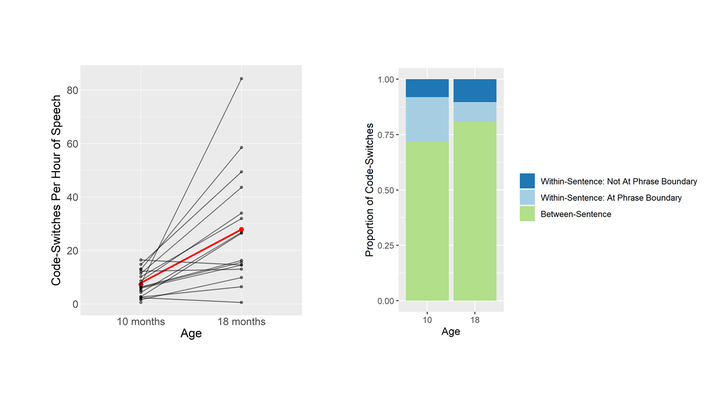 The number of infant-directed code-switches produced per hour by each family at each age. The red line shows the change in average frequency across ages (left). The proportion of parents’ code-switches at different syntactic locations across ages (right).
The number of infant-directed code-switches produced per hour by each family at each age. The red line shows the change in average frequency across ages (left). The proportion of parents’ code-switches at different syntactic locations across ages (right).Abstract
Bilingual parents code-switch, or mix their two languages, when speaking to their infant. Parental code-switching may influence infants’ language development. For example, code-switching slows language processing (Byers-Heinlein, Morin-Lessard, & Lew-Williams, 2017; Potter, Fourakis, Morin-Lessard, Byers-Heinlein, & Lew-Williams, 2019), hinders word recognition (Morini & Newman, 2019), and may impact vocabulary development (Byers-Heinlein, 2013). However, little is known about parents’ code-switching habits in daily life, and even less is known about how parental code-switching may change across the infant’s development. To address this gap in knowledge, we examined parents’ natural code-switching behaviors in a corpus of infants’ language environments, recorded using Language ENvironment Analysis (LENA) devices (Orena, Byers-Heinlein, & Polka, 2019). We asked how the frequency, syntax, and motivation of parents’ code-switching may change across their infant’s development.
Method
Sixteen French-English bilingual families in Montréal contributed three full-day recordings when their infant was 10 months old, and an additional day when their infant was 18 months old. We defined code-switching as any language change by a single speaker directed to the infant. Research assistants identified instances of code-switching, their syntactic location, and the apparent reason for the switch. Here, we report preliminary data from 448 hours of recordings provided by 7 families.
Q1. How often do parents code-switch?
At 10-months, parents code-switched on average 6 times per hour when speaking to their infant. At 18-months, the frequency of code-switching substantially increased in 5 out of the 7 families to an average of 16 times per hour (See Figure on left).
Q2. Where do parents code-switch syntactically?
At each age, we calculated the proportion of code-switches that occurred at three different syntactic locations, 1) between-sentences, 2) within-sentence at a phrase boundary, and 3) within-sentence not at a phrase boundary. Between-sentence code-switches were the most frequent at each age. The proportion of code-switches that occurred between-sentences and within-sentence not at a phrase boundary increased in frequency between 10- and 18-months (See Figure on right).
Q3. Why do parents code-switch?
At both 10- and 18-months, parents appeared to code-switch most frequently to enhance their infant’s understanding (57% and 58%, respectively). The use of conventionalized borrowings (e.g., “bon appétit”) was the second most frequent reason at each age (14% at 10-months and 15% at 18-months). The largest change was that parents code-switched to teach vocabulary more at 18-months (12%) than at 10-months (4%).
Conclusion
These results show that a) the frequency of code-switching increased across the infants’ development, b) most code-switches occur between-sentences, regardless of age, and c) that parents most frequently code-switched to boost their infant’s understanding and code-switched to teach vocabulary more at an older age. Taken together, these results suggest parents’ code-switching habits do change across their infant’s development. Parents alter other aspects of their speech in response to their infant’s development, such as tone, pitch, and vowel articulation (Kitamura & Burnham, 2003; Kitamura & Lam, 2009; Lam & Kitamura, 2012). Our results might therefore reflect how bilingual parents change in response to their infant’s developing language abilities to use code-switching more strategically.